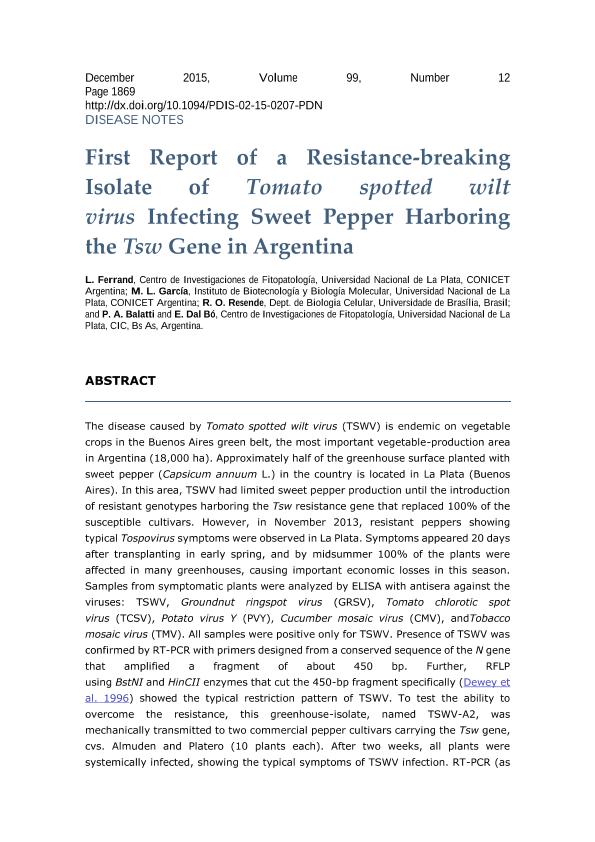Mostrar el registro sencillo del ítem
dc.contributor.author
Ferrand, Luciana

dc.contributor.author
Garcia, Maria Laura

dc.contributor.author
R.O. Resende
dc.contributor.author
Balatti, Pedro Alberto

dc.contributor.author
Dal Bó, E
dc.date.available
2018-06-11T20:31:18Z
dc.date.issued
2015-06
dc.identifier.citation
Ferrand, Luciana; Garcia, Maria Laura; R.O. Resende; Balatti, Pedro Alberto; Dal Bó, E; First report of a resistance-breaking isolate of Tomato spotted wilt virus infecting sweet pepper harboring the Tsw gene in Argentina; American Phytopathological Society; Plant Disease; 99; 12; 6-2015; 1869
dc.identifier.issn
0191-2917
dc.identifier.uri
http://hdl.handle.net/11336/48172
dc.description.abstract
The disease caused by Tomato spotted wilt virus (TSWV) is endemic on vegetable crops in the Buenos Aires green belt, the most important vegetable-production area in Argentina (18,000 ha). Approximately half of the greenhouse surface planted with sweet pepper (Capsicum annuum L.) in the country is located in La Plata (Buenos Aires). In this area, TSWV had limited sweet pepper production until the introduction of resistant genotypes harboring the Tsw resistance gene that replaced 100% of the susceptible cultivars. However, in November 2013, resistant peppers showing typical Tospovirus symptoms were observed in La Plata. Symptoms appeared 20 days after transplanting in early spring, and by midsummer 100% of the plants were affected in many greenhouses, causing important economic losses in this season. Samples from symptomatic plants were analyzed by ELISA with antisera against the viruses: TSWV, Groundnut ringspot virus (GRSV), Tomato chlorotic spot virus (TCSV), Potato virus Y (PVY), Cucumber mosaic virus (CMV), and Tobacco mosaic virus (TMV). All samples were positive only for TSWV. Presence of TSWV was confirmed by RT-PCR with primers designed from a conserved sequence of the N gene that amplified a fragment of about 450 bp. Further, RFLP using BstNI and HinCII enzymes that cut the 450-bp fragment specifically (Dewey et al. 1996) showed the typical restriction pattern of TSWV. To test the ability to overcome the resistance, this greenhouse-isolate, named TSWV-A2, was mechanically transmitted to two commercial pepper cultivars carrying the Tsw gene, cvs. Almuden and Platero (10 plants each). After two weeks, all plants were systemically infected, showing the typical symptoms of TSWV infection. RT-PCR (as previously described) from total RNA extracted from symptomatic leaves of these plants confirmed the presence of TSWV-A2. Therefore, we demonstrated that TSWV-A2 is able to overcome Tsw gene resistance. Furthermore, to amplify the complete N gene of TSWV-A2 isolate, a new RT-PCR was carried out (Lovato et al. 2008). A specific 800-bp product was cloned and sequenced (GenBank Accession No. KP719131). BLAST analysis showed that the sequence was 99% homologous at the nucleotide as well as the amino acid sequence to the N gene of isolates EF195230 and EF195224 from South Korea (Kim et al. 2004). In addition, TSWV-A2 shared common characteristics with the resistant-breaking isolates infecting sweet pepper cultivars carrying the Tsw gene, previously reported in Italy (Roggero et al. 2002) and Spain (Margaria et al. 2004). Overall, based on biological, serological, and molecular features, this is the first report of a local isolate of TSWV breaking the Tsw-resistance in sweet pepper in Argentina.
dc.format
application/pdf
dc.language.iso
eng
dc.publisher
American Phytopathological Society

dc.rights
info:eu-repo/semantics/openAccess
dc.rights.uri
https://creativecommons.org/licenses/by-nc-sa/2.5/ar/
dc.subject
Tospovirus
dc.subject
Pepper
dc.subject
Resistance Breaking
dc.subject.classification
Otras Biotecnología Agropecuaria

dc.subject.classification
Biotecnología Agropecuaria

dc.subject.classification
CIENCIAS AGRÍCOLAS

dc.title
First report of a resistance-breaking isolate of Tomato spotted wilt virus infecting sweet pepper harboring the Tsw gene in Argentina
dc.type
info:eu-repo/semantics/article
dc.type
info:ar-repo/semantics/artículo
dc.type
info:eu-repo/semantics/publishedVersion
dc.date.updated
2018-06-08T14:26:22Z
dc.journal.volume
99
dc.journal.number
12
dc.journal.pagination
1869
dc.journal.pais
Estados Unidos

dc.journal.ciudad
St. Paul
dc.description.fil
Fil: Ferrand, Luciana. Universidad Nacional de la Plata. Facultad de Ciencias Agrarias y Forestales. Departamento de Ciencias Biológicas. Centro de Investigaciones de Fitopatología. Provincia de Buenos Aires. Gobernación. Comision de Investigaciones Científicas. Centro de Investigaciones de Fitopatología; Argentina
dc.description.fil
Fil: Garcia, Maria Laura. Consejo Nacional de Investigaciones Científicas y Técnicas. Centro Científico Tecnológico Conicet - La Plata. Instituto de Biotecnología y Biología Molecular. Universidad Nacional de La Plata. Facultad de Ciencias Exactas. Instituto de Biotecnología y Biología Molecular; Argentina
dc.description.fil
Fil: R.O. Resende. Universidade do Brasília; Brasil
dc.description.fil
Fil: Balatti, Pedro Alberto. Universidad Nacional de la Plata. Facultad de Ciencias Agrarias y Forestales. Departamento de Ciencias Biológicas. Centro de Investigaciones de Fitopatología. Provincia de Buenos Aires. Gobernación. Comision de Investigaciones Científicas. Centro de Investigaciones de Fitopatología; Argentina
dc.description.fil
Fil: Dal Bó, E. Universidad Nacional de la Plata. Facultad de Ciencias Agrarias y Forestales. Departamento de Ciencias Biológicas. Centro de Investigaciones de Fitopatología. Provincia de Buenos Aires. Gobernación. Comision de Investigaciones Científicas. Centro de Investigaciones de Fitopatología; Argentina
dc.journal.title
Plant Disease

dc.relation.alternativeid
info:eu-repo/semantics/altIdentifier/doi/http://dx.doi.org/10.1094/PDIS-02-15-0207-PDN
dc.relation.alternativeid
info:eu-repo/semantics/altIdentifier/url/https://apsjournals.apsnet.org/doi/10.1094/PDIS-02-15-0207-PDN
Archivos asociados
